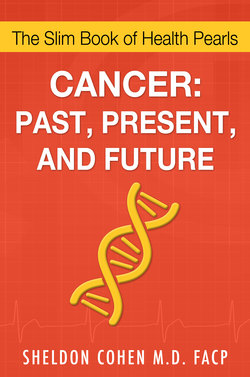Читать книгу Cancer: Past, Present, and Future - Sheldon Cohen M.D. FACP - Страница 5
На сайте Литреса книга снята с продажи.
CHAPTER 3 Big-Data
ОглавлениеGiven for one instant an intelligence which could comprehend all the forces by which nature is animated and the respective positions of the beings which compose it, if moreover this intelligence were vast enough to submit these data to analysis. It would embrace in the same formula both the movements of the largest bodies in the universe and those of the lightest atom; to it nothing would be uncertain, and the future as the past would be present to its eyes.
Pierre Simon de Laplace
1749-1827
You don’t have to be a physician, to grasp the idea that prevention of any disease is a lot simpler and safer than treating a disease once developed. Because once a disease has developed, the horse is out of the barn and it may gallop away before it can be reined in. This concept applies to a disease of any type, but is especially relevant with cancer where the earlier a group of cancerous cells is identified, the better it is for the patient. Examples include regular mammographic screening for breast cancers, skin screenings for skin cancers, Pap smears for gynecological cancers, prostate-specific antigen (PSA) for prostatic cancer.
For many years the physician population lived with the idea that the earlier the better when it comes to cancer discovery; and screening continued unabated. Although the percentage of individuals who availed themselves of this important preventive approach remained depressingly lower than preventive medical experts hoped for. Once the statistics rolled in, things slowly changed; and that complicated things for physicians always enamored with simplistic concepts such as “the earlier the better.” The monkey wrench was lobbed into the physician population by the United States Preventive Services Task Force (USPSTF).
Before we detail that monkey wrench, what is the USPSTF? Started in 1984 by the Federal Government it represents a selected group of well-paid primary care physicians, nurses, epidemiologists, and statisticians mandated to focus on the scientific evidence related to screening tests used by the medical profession for early disease detection and prevention. The “Big Data” was in the process of analysis.
The USPSTF’s decisions impacted not only patients, but physicians, insurance companies, and laboratories, resulting in usually prompt angry protests from these disparate groups especially as financial considerations enter the picture and as cost-effectiveness rears its ugly but crucial head. Examples:
1.In 2009 it made a recommendation to abandon the yearly mammogram requirement for most women between the ages of 40 to 50, but rather start at age 50. This was based upon the unfavorable benefit to risk ratio of doing this test in the 40 to 50 age group: the large number of false positive mammography’s and the negative consequences of doing unnecessary procedures based upon false positive results.
2.It also recommended eliminating the yearly PSA test for prostate cancer for men ages 40 to 54. This too emanated from the fact that false positive PSA’s and the necessary biopsies resulting from same in this age group were causing significant morbidity. Men from 55 to 69 years of age may have the test done if the doctor and patient agree. Men over age 70 or any man with less than a 10 to 15 year life expectancy could forgo the PSA test.
3.Screening tests for colon cancer, including stool blood tests, sigmoidoscopy or colonoscopy are recommended all at intervals agreed upon by the physician and patient based upon clinical facts.
4.There are no decisions currently about any definite effective lung cancer screening tests.
5.There is no definite determination whether whole body skin examinations for melanoma are beneficial or harmful.
This is all part of the big-data revolution taking place in healthcare today: data from clinical trials, years of research from pharmaceutical companies, insurance data on patients with various diseases, information from payers, hospital data, laboratory data, physician practice data, all congregated and studied with the goal in mind to streamline healthcare from the medical standpoint as to what is best for patients, and from the financial standpoint as the cost of healthcare, which if left unattended, may well break the bank. And this latter pressure is the main factor driving this demand for medical and fiscal responsibility.
Now if all patients would just play a role in their own health by not smoking, not drinking alcohol, exercising regularly, follow preventive measures, and eat with optimal health in mind, our medical and financial healthcare crisis would be moderated to the point where much of our worries and financial and medical pressures would minimize. And what a boon that would be!
